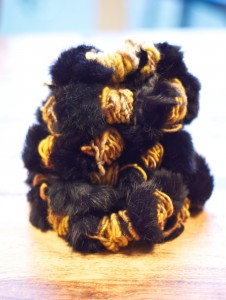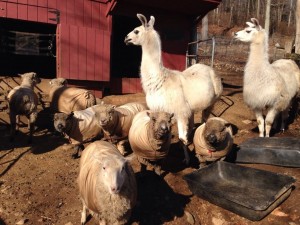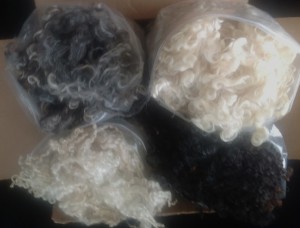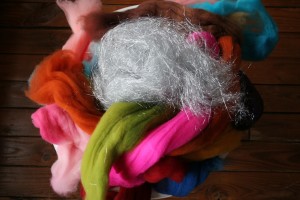
As a beginner spinner, I remember fiber being, well, just fiber. And, there were all of these strange terms such as “batt”, “rolag”, and “combed top”. It was confusing…remember, I wasn’t a natural with my wheel and to make matters worse, I wanted to cling to the idea that any fiber would do!
But, slowly my understanding regarding fibery-related matters started to become clearer. I learned about staple length. I watched old dvd’s from master spinners like Rita Buchanan. The “Ashford Book of Spinning” took up residence on the nightstand next to the bed.
And, one day, I was at a friend’s farm buying some fleece and my friend who is a wonderful spinner said, “Fiber prep is everything.”
My earth stood still upon hearing that simple phrase.
Oh….so that’s why I couldn’t spin a smooth single from a gorgeous, textured art batt…and that is why that combed top wouldn’t produce chunky, wild, straight-off-the-sheep yarns. It seems like common sense now, but like I said before, I wasn’t a natural at any of this.
So, if you are new to all of this, I’m here to hopefully save you some heartache by telling you that you are much more likely to get the yarn you want from fiber that is prepped for that outcome. Therefore in this post, we going to cover some of the big considerations regarding fiber preparation and point you to some resources to help you in your continued studies. Hopefully, you more experienced fiber-istas will find some resources in this round up to be of interest also! This post is by no means intended to infer that it is a complete discussion but perhaps will perk your interest in learning more on any of these sub-topics and exploring some of these resources.

Consideration #1: Fiber selection – Animal, plant or?
To help keep this post from being way, way too long, I am going to confine the discussion to wool since that is what most of us work with to a large degree. And, as I was thinking about writing this post, I thought it would not be fair to jump right into fiber prep without first talking a little bit about breed selection with wool. This is a long involved topic unto itself so I’m just going to touch briefly on this part. There is a vast difference between what your yarn is going to be based upon the breed(s) of sheep that produced the fiber. There are some very good books on this topic — here are links to some of my favorites:
The Spinner’s Notebook by Pam Blasko
The Fleece and Fiber Sourcebook by Deborah Robson
The Field Guide to Fleece by Carol Ekarius and Deborah Robson
All of these are wonderful additions to your library; however, The Spinner’s Notebook is very unique as Pam has included actual fiber samples so that you can actually experience the fiber.
And here is great free resource:
A mini class available through Craftsy , Know Your Wool with Deborah Robson as the instructor.
Learning about the sheep breeds you might be interested in working with can seem like trying to eat an elephant…which can’t be done in one big bite…if you are a beginner, try to narrow your study down to a two to three breeds to learn and experience. Your budget, location (if you are buying locally produced fibers) and personal preferences all come into play here.
 Consideration #2: To Wash or Not to Wash?
Consideration #2: To Wash or Not to Wash?
You don’t have to if you don’t want to. There are lots of options either way. If you haven’t tried it, at some point you probably should or will and then you can decide if it’s for you. It can be the most economical way to build your fiber stash…that is if you don’t go crazy and start hoarding precious fleeces. It can be satisfying to take a dirty, discolored, stinky pile of fleece and transform it into beautiful fluff. On the other hand, maybe you have allergies to some of the substances hiding in the fleece (me!) or you don’t have a good set up at home. Or maybe you just feel overwhelmed by trying to figure it out what to buy and how to buy it and you are afraid you would ruin the fiber in attempting to wash it. Well, those particular reasons we can get rid of and here are three great free resources to help you with that:
Which Fleece? by Suzy Brown aka Wool Wench
Fleece Shopping Video Tutorial by Esther Rodgers of Jazz Turtle Creations and Arlene Thayer of www.spinartiste.com
Washing Fiber by Suzy Brown aka Wool Wench
If you decide not to wash, there are no end to folks that will sell you washed fiber. There is even a Facebook group just for this: Washed Fiber for Sale. Another alternative that I practice now that I have determined it’s not good for my health to wash fiber is to buy the fleece and take it to a mill and have them do it. It’s a good option; although, washing yourself is still best.
You can also spin the unwashed wool also known as “spinning in the grease”. I found this little write up from wikipedia rather interesting on that topic:
“Handspinners are split, when spinning wool, as to whether it is better to spin it ‘in the grease’ (with lanolin still in) or after it has been washed. More traditional spinners are more willing to spin in the grease, as it is less work to wash the wool after it is in yarn form. Spinners who spin very fine yarn may also prefer to spin in the grease as it can allow them to spin finer yarns with more ease. Spinning in the grease covers the spinner’s hands in lanolin and, thus, softens the spinner’s hands.
Spinning in the grease works best if the fleece is newly sheared. After several months, the lanolin becomes sticky, which makes the wool harder to spin using the short-draw technique, and almost impossible to spin using the long-draw technique. In general, spinners who use the long-draw technique do not spin in the grease.
Such spinners generally buy their fibers pre-washed and carded, in the form of roving, sliver, or batts. This means less work for the spinners, as they do not have to wash out the lanolin. Spinners then have available predyed fiber, or blends of fibers, which are hard to create when the wool is still in the grease. As machine carders cannot card wool in the grease, pre-carded yarn generally is not spun in the grease. Some spinners use spray-on lanolin-like products to get the same feel of spinning in the grease with carded fiber.”

Consideration #3: Locks, Picked, Carded, Combed?
Now, that we have set the stage, we are at the heart of the matter. Again, to limit the scope of this post, I’m bypassing the whole topic of dyeing fiber as that is a vast subject unto itself.
For purposes of this discussion, by “locks”, I’m referring to the fiber that has not been processed in any other way other than washing. Picking is using done by a picker or can be done by hand (a laborious project that is well suited to being performed while watching a very long movie). Carding may be done with hand carders or a drum carder and arranges the fibers in a way that opens up the fibers and makes them easy to spin. Combing is done by the hand spinner with hand combs and straightens the fibers just like combing your hair with a comb.
So, you see this is a general spectrum in terms of what your finished product can achieve from chunkiest/lumpiest/thickest to smoothest/finest yarns: Locks – Picked – Carded – Combed.

Picking, carding and combing can all be done at home with the right equipment. As a new spinner, you might want to hold off until you know yourself as a spinner better before making the financial and space commitment to more equipment. In the meantime, there are a vast array of fiber sellers who have beautiful batts, rolags, handpainted or hand dyed combed top available. If you do decide to buy processing equipment and you are watching your dollars and have a little patience, often you can find good quality used equipment (Ravelry Groups: Spinner’s Marketplace and Knit & Spin Equipment Classifieds; Facebook Group: Fiber Processing Equipment for Sale; and Craigslist are all good places to look).
However, for those of you who are ready to take the plunge into processing beyond the washing and dyeing, here are some great resources:
Carding a Jazzy Batt by Esther Rodgers aka JazzTurtle Creations
Making Your Own Roving by Suzy Brown aka WoolWench
Majacraft Mini Comb Tutorial by Pat Old
Making Rolags on a Blending Board by Suzy Brown aka WoolWench & Majacraft
There are many, many more resources than I’ve listed. A Youtube search will yield you much on all of these subjects. After you’ve got your fiber prep decided, you also need to match it up with the tension and ratio options on your wheel which we will get into another time.
But for now, if you are a beginner, start to explore some of the possibilities of different fiber preparations to see what you like and if you are getting the types of yarns from the preparations you are using. Do not make the mistake of thinking that you are spinning “wrong” when in fact, you make just not be working with a preparation type that is going to give you the outcome you want.
If you are more experienced, challenge yourself by making different choices than you usually do with your fiber preparation. If you like spinning combed top, for example, try running it through a drum carder to open it up and make it fluffier. If you always spin textured art batts, grab some uncarded fiber and hand pick it in your lap with some other add ins and spin from there. If you are with us on the Journey to the Golden Fleece, we have a special resource for you in Module Two called the Yarn Randomizer that is designed to shake you out of any ruts you might be in!
Our current class in the Journey to the Golden Fleece are deep into their Module One yarn making and we are having a great time! We are going to be opening up for a new class in February — make sure to get on the mailing list here at www.fiberygoodness.com to get the announcement when enrollment opens again as we take a limited number of participants.
Until next time, we wish you much fibery goodness — Arlene

another great article…so much fiber, not enough time
Very informative page, thank you!
Great information. I learn something new all the time from these articles.
really good info…addresses fears of every new fiberista!!!